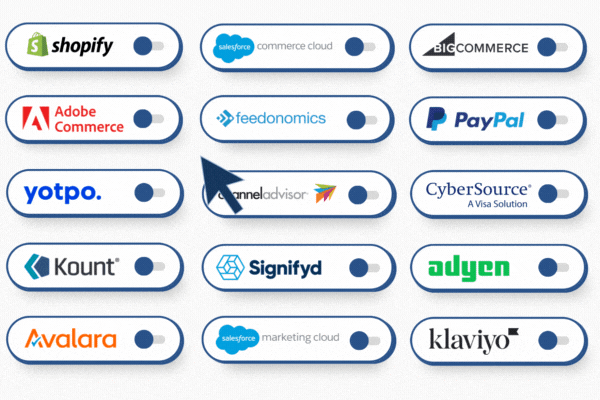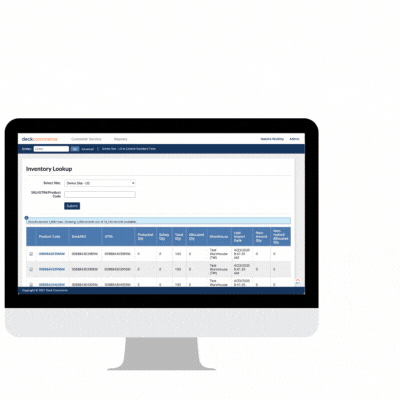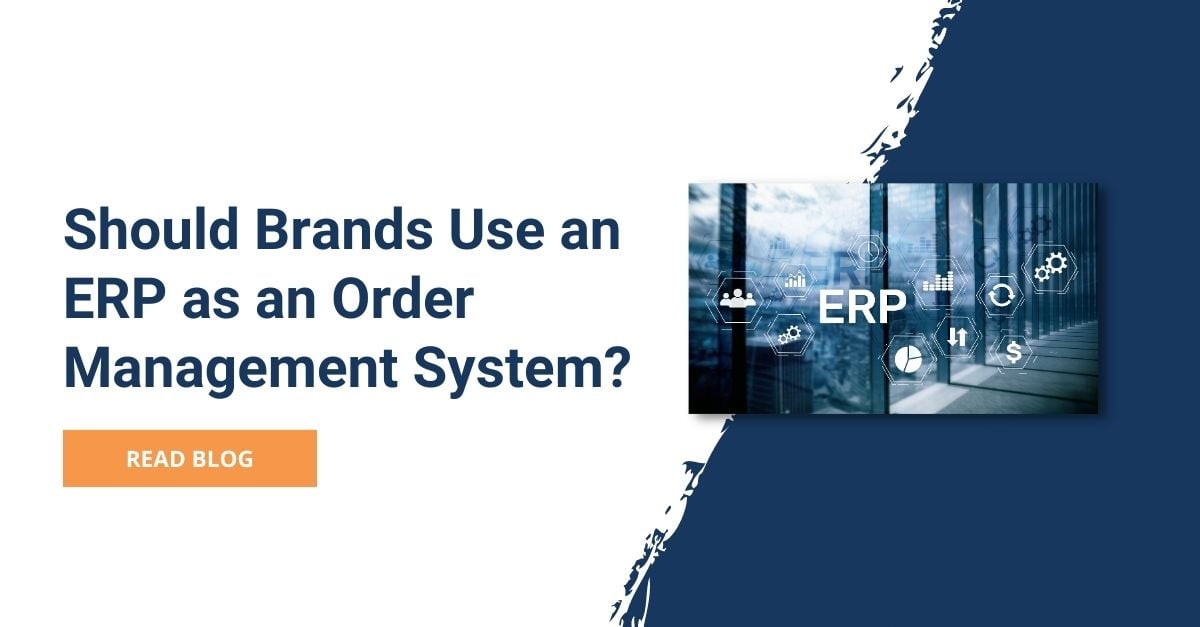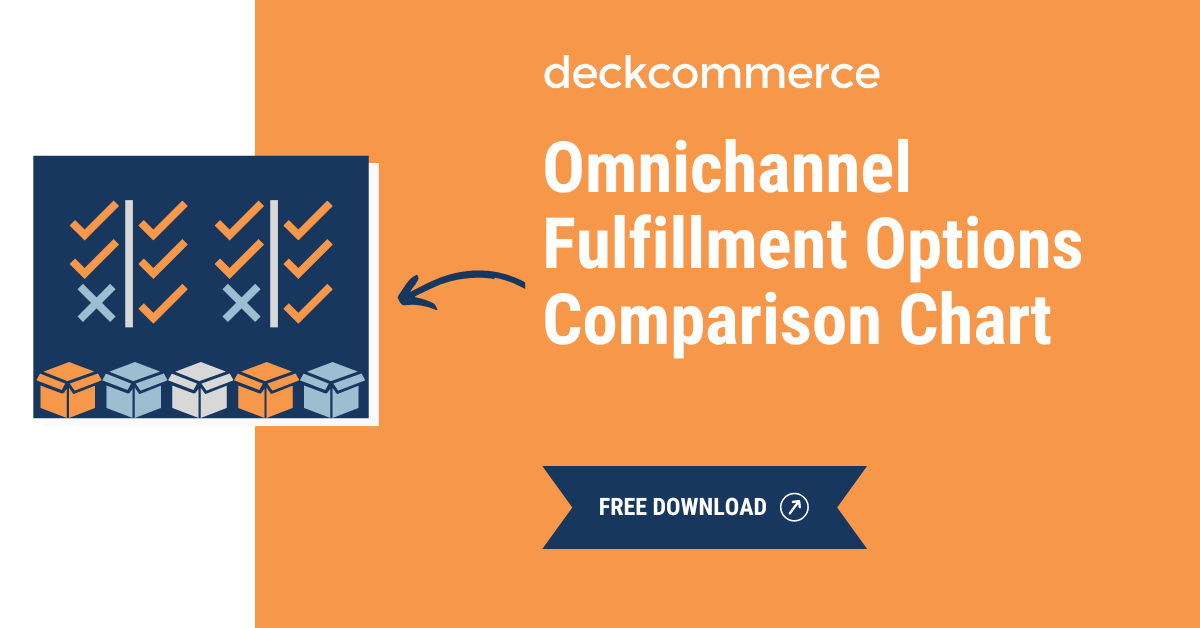Complex to Composable: Shifts in Enterprise Order Management Software

As consumer shopping behaviors evolve, many enterprise brands face a race to adapt their technology stacks to meet these changing demands. This rapid shift has left many grappling with the complexities of their order management systems and processes.
Our blog explores this digital transformation, highlighting key trends in enterprise order management from complex systems to a more streamlined, composable approach.
We’ll explore the inherent limitations of conventional eCommerce platforms and storefronts, the challenges of repurposing ERP software for order management, and the strategic ascent of composable commerce.
Furthermore, we'll illustrate how an advanced Order Management System (OMS) addresses these challenges and acts as a pivotal enabler for businesses transitioning towards a flexible, future-proof digital infrastructure.
Join us as we unpack the nuances of these enterprise order management trends, offering valuable insights and actionable strategies to help enterprise-level brands navigate the shift from complex to composable, ensuring they remain competitive and responsive in today's fast-evolving consumer environment.
The Complexity of Order Management for Enterprise Brands
.png?width=500&height=500&name=website%20images%20-%20Free%20Downloads%20(15).png)
For large brands, the complexity of order management is a multifaceted challenge.
Addressing these additional complexities requires a comprehensive and flexible order management system capable of handling the scale and diversity of enterprise-level operations.
Challenge |
Complexity |
|
Omnichannel Efficiency |
Balancing a cohesive brand experience across multiple sales channels like online, brick-and-mortar stores, and marketplaces. |
|
Distributed Order Fulfillment |
Managing a network of warehouses and fulfillment centers efficiently. |
|
Rising Shipping Costs |
Handling increasing global logistics costs while maintaining delivery standards. |
|
Customer Experience Management |
Ensuring fast, accurate order processing and smooth handling of returns/exchanges. |
|
Global Scale Operations |
Navigating diverse regulatory, taxation, and compliance challenges across different regions. |
|
Integration with Legacy Systems |
Seamlessly integrating new solutions with existing systems without disrupting operations. |
|
Inventory Accuracy and Visibility |
Maintaining real-time inventory accuracy and visibility across all channels and locations. |
|
Supply Chain Volatility |
Adapting to disruptions and variability in the supply chain. |
|
Data Security and Compliance |
Ensuring data security and compliance, especially with sensitive customer information. |
Native Order Management Limitations of Most eCommerce Platforms & Storefronts

Platforms like Shopify, Magento, and BigCommerce excel as user-friendly storefronts, offering optimized user experiences that cater to a broad range of customers.
While they function efficiently as sales platforms, their capabilities in handling the intricate order management processes required for enterprise-scale operations are limited.
This gap underscores the necessity for more robust, feature-rich order management systems tailored to the unique demands of larger, more complex business models.
These limitations are primarily evident in the following areas:
- Scalability: As businesses grow, these platforms may struggle to handle the increased volume and complexity of enterprise-level operations efficiently.
- Configuration: Standard solutions may not offer the configurations needed for unique business models and processes typical of large-scale enterprises.
- Integration with Complex Systems: There can be challenges in integrating these platforms seamlessly with advanced ERP systems, third-party logistics, and other critical business tools.
- Advanced Analytics and Reporting: These platforms might not provide the comprehensive analytics and reporting capabilities required for strategic decision-making at an enterprise level.
- Global Commerce Capabilities: Handling international sales, multiple currencies, and cross-border taxation can be challenging with standard storefront solutions.
The Downside of Using ERP Software as an Order Management System
While Enterprise Resource Planning (ERP) systems are foundational for managing various aspects of a business, including finance, supply chain, and human resources, they present notable challenges when repurposed for order management, especially for direct-to-consumer (DTC) operations.
Cost & Complexity
ERPs, designed to be comprehensive, often require extensive customization to meet specific order management needs. This increases costs and leads to a complex "Franken-system" that's difficult to maintain and update.
The initial cost savings from bundling order management with an ERP can quickly be overshadowed by the expenses and resources needed for customizations.
Limited Customer Flexibility
In today's fast-paced market, customers expect seamless, flexible, and rapid service. ERPs typically lack the agility to adapt quickly to changing consumer demands, such as offering various payment options or omnichannel fulfillment experiences.
Risk to Financial Data Integrity
Using an ERP for order management often requires significant modifications to the system. Over-customizing ERP systems for order management can jeopardize the integrity of financial data, posing a risk to crucial business operations.
Inhibits Growth & Innovation
As brands evolve, the need to integrate new technologies, services, and sales channels becomes crucial. ERPs, with their inherent inflexibility and integration challenges, can make it difficult for brands to adopt innovative solutions swiftly, thus impeding growth.
Facilitating the Shift to Composable Commerce
The limitations of using ERP software for order management underscore the necessity for a more adaptable, scalable solution. This is where the concept of composable commerce comes into play. By leveraging a dedicated OMS with their ERP, brands can embrace the flexibility and modularity of composable commerce, allowing them to easily integrate best-of-breed solutions tailored to their unique needs.
Unlike ERPs, a dedicated OMS is designed to seamlessly connect with a variety of e-commerce tools and systems, paving the way for businesses to construct a technology ecosystem that's agile, customer-centric, and poised for innovation and growth
The Rise of Composable Commerce
Many enterprise brands are reevaluating their reliance on unified, all-encompassing e-commerce platforms. These monolithic systems, while designed for simplicity, often fall short in catering to the nuanced requirements of large-scale operations.
The shift towards composable commerce marks a pivotal change in the e-commerce landscape. This approach champions modular and adaptable frameworks, empowering businesses to curate and integrate various technologies and systems tailored to their distinct needs.
Its growing reputation is driven by the need for agility, modularity, and customization.
A survey of 200 retail executives by Elastic Path revealed a significant move towards composable solutions, with 92% of respondents indicating they have implemented a composable approach. This shift underscores the urgent need for brands to adopt flexible, scalable solutions capable of evolving with their growth and changing market demands.
Key challenges driving brands towards composable commerce include:
- Increasing Speed to Market: The model allows for rapid adaptation and deployment of new technologies, significantly reducing the time to market for new features or services.
- Easy Integration with Other Technology Tools: It provides seamless integration capabilities, enabling brands to connect and manage their technology stack more easily.
- Quick Adaptation to Market and Consumer Trends: The flexibility means brands can swiftly respond to shifting consumer preferences and market dynamics.
- Reduced Complexity and Total Cost of Ownership: Enabling brands to select only the necessary components reduces system complexity and the overall cost of ownership, freeing resources for innovation and growth.
- Support for Multiple Business Models: The modular nature of composable commerce supports diverse business models, facilitating expansion and diversification.
- Consistent User Experience Across All Touchpoints: Ensures customers have a uniform experience, regardless of how or where they interact with the brand.
"One notable concern among executives is the implementation timeline; thus, selecting a vendor that ensures seamless integration with existing systems is crucial for accelerating the launch," the report from Elastic Path advises.
8 Must-Have Features of an Enterprise Order Management System
The pivot to composable commerce underscores the critical role of an advanced Order Management System (OMS).
The right OMS facilitates this transition and ensures that a brand's digital operations are ready for future challenges and opportunities. Seamless integration with existing systems is key, making the OMS the central piece that simplifies the move to composable commerce, ensuring swift implementation and long-term scalability.
Here’s what to look for when choosing an OMS for enterprise scale.
1. Inventory Management

An advanced OMS will equip enterprises with the capabilities mentioned below, ensuring they can manage their inventory efficiently and meet customer demand without overstocking or running into shortages.
Real-Time Inventory Visibility
This involves tracking inventory levels across all sales channels and warehouses in real-time, ensuring accurate stock counts and quick responses to changes in demand.
Automated Replenishment
A sophisticated OMS will automate inventory replenishment based on predefined thresholds and historical sales data to avoid stockouts.
Multi-Location Management
Effective inventory management across various physical locations, including stores, warehouses, and fulfillment centers, is crucial for optimized stock distribution.
Seasonal and Promotional Demand Planning
The ability to adjust inventory levels in response to seasonal changes and promotional campaigns is key to maintaining the right stock balance.
Analytics & Reporting
Detailed analytics and reporting capabilities help forecast future inventory needs and identify trends or issues in inventory management.
2. Advanced Order Orchestration & Routing
![]()
Dynamic Order Allocation
The system analyzes inventory locations, shipping options, costs, and delivery times to determine the best fulfillment center for each order.
For example, if a customer from New York places an order, the OMS might choose the nearest warehouse with available stock in New Jersey or their local retail store for faster and cost-effective delivery.
Complex Order Processing
- Pre-orders: The system is designed to manage orders for products not yet available, ensuring they are queued for fulfillment as soon as the stock arrives.
- Backorders: In cases where demand exceeds supply, the OMS effectively manages and tracks orders that are placed on hold until the inventory is replenished.
- Custom Orders: For orders that require personalization or specific configurations, the OMS ensures that these unique requirements are accurately captured and routed to the appropriate fulfillment process.
Scalability for High Volume
This capability is crucial for large-scale sales events or peak seasons where order influx is notably high. An effective OMS not only processes these orders rapidly but also maintains accuracy in order tracking, inventory allocation, and customer communication.
It leverages robust computing resources and optimized algorithms to ensure that every order, regardless of the surge in volume, is managed efficiently, thereby upholding the brand's commitment to prompt service and reliability.
Logistics & Carrier Integrations
Seamlessly connects with logistics providers and carrier systems for real-time tracking and efficient dispatch.
Contingency Handling
In cases of stock unavailability or logistic disruptions, the system quickly reroutes orders to alternate locations or adjusts delivery expectations.
3. Enterprise-Level Distributed Order Management Solutions
Distributed Order Management (DOM) is a strategic approach to managing orders across a complex network of fulfillment centers, warehouses, and retail stores.
It optimizes the fulfillment process by selecting the most efficient location for each order.
Key aspects include:
- Centralized Order Visibility: Provides a single view of all orders across the network, regardless of the point of origin or fulfillment location.
- Cross-Channel Inventory Management: Synchronizes inventory levels across different channels and locations, ensuring accurate stock availability.
- Smart Order Routing: Uses algorithms to determine the best fulfillment center based on factors like proximity to the customer, inventory availability, and shipping costs.
- Fulfillment Flexibility: Adapts to changes in demand or supply, rerouting orders as needed to maintain efficiency and meet delivery commitments.
DOM systems revolutionize order management by integrating a web of fulfillment centers, warehouses, and retail outlets into a cohesive, efficient network.
This comprehensive approach ensures that each order is fulfilled from the most advantageous location, enhancing overall operational efficiency.
4. Transaction Processing
For enterprise-level brands, the transaction processing capabilities of an OMS are not just about facilitating sales; they're about creating a seamless customer experience throughout the entire order journey.
Here’s how an OMS impacts transaction processing.
- Robust Security Measures: An OMS protects transactions with top-tier encryption and global security standards, essential for customer trust and data protection.
- Diverse Payment Options: Reflecting composable commerce's emphasis on flexibility, an OMS integrates with a diverse array of payment methods—from digital wallets to BNPL services—catering to varied consumer preferences and expanding market reach.
- Multi-Currency Support: Facilitates payments in numerous currencies, managing local taxes and conversions smoothly, enabling global sales without operational complexities.
- Customer Notifications: Automatically notify customers about the status of their order every step of the way—from fulfillment status, through delivery, and returns.
These capabilities align with composable commerce's modular and adaptable nature and enable businesses to meet current and future e-commerce demands.
5. Returns Management
Effective returns management becomes a key differentiator with the shift towards more adaptable and tailored e-commerce solutions. An advanced OMS becomes a linchpin in addressing the complexities of returns, especially in a composable commerce environment where flexibility and customer experience are paramount.
Here's how an OMS transforms returns management from a logistical challenge into an opportunity to reinforce customer loyalty and streamline backend operations.
Capabilities |
The Impact On Businesses |
|
Holiday Returns Surge |
The holiday shopping season often results in a high volume of returns due to early sales and deep discounts. Despite economic uncertainties, consumer spending resilience leads to a notable return increase, emphasizing the need for robust returns management to maintain customer loyalty and protect the bottom line. |
|
Customer-Controlled Returns |
An OMS empowers customers to initiate returns through digital platforms, reducing the need for customer service intervention and enhancing the self-service experience. |
|
Automated Returns Process |
From generating Return Merchandise Authorization (RMA) numbers to providing real-time updates on return status, automation streamlines operations and improves customer transparency. |
|
Incentives to Retain Sales |
Innovative solutions like refunds to gift cards or offering immediate store credit encourage customers to remain within the brand ecosystem, potentially converting returns into exchanges. |
|
Omnichannel Returns Capability |
Facilitating returns across various channels, including in-store options, aligns with consumer expectations for seamless experiences, leveraging potential in-store exchanges or additional purchases. |
|
Efficiency in Operational Workflow |
Integration with warehouse and logistics systems, coupled with automated returns processing, significantly reduces the time and resources required for managing returns, even during peak return periods. |
6. Omnichannel Fulfillment
For enterprise brands to thrive in today's retail landscape, the ability to offer an integrated omnichannel experience is non-negotiable.
Consumers no longer see a distinction between online and physical store shopping; they expect a cohesive journey across all touchpoints. An order management system that excels in omnichannel fulfillment is not just an asset; it's a necessity for success.
Seamless Channel Integration
A top-tier OMS ensures that whether a customer shops online, via mobile, or in a physical store, the experience is consistent and fluid. This includes uniform access to promotions, loyalty programs, and inventory visibility. The system should effortlessly sync online and offline sales channels, providing real-time updates across the board.
Unified Customer Experiences
Beyond logistical efficiencies, the core of omnichannel fulfillment is the customer experience. An effective OMS facilitates a journey where every interaction, from discovery to purchase and beyond, feels personalized and connected.
This means enabling services like Buy Online, Pick Up In-Store (BOPIS), easy returns across channels, and personalized recommendations based on cross-channel behavior.
Inventory Transparency
Central to omnichannel success is accurate, real-time inventory visibility across all locations. An OMS should offer a single source of truth for inventory, allowing brands to confidently sell products without the risk of overselling or stockouts.
This transparency optimizes inventory levels and enhances customer trust by ensuring that what they see online matches what's available.
Efficient Order Routing
Smart order routing is another critical feature, determining the most efficient fulfillment center or store for each order based on factors like proximity to the customer, shipping costs, and inventory availability. This not only reduces delivery times and costs but also contributes to sustainability efforts by minimizing shipping distances.
Adaptability & Scalability
As brands grow and market dynamics shift, an OMS must be adaptable, capable of integrating new channels, technologies, and fulfillment methods. It should scale with the business, supporting global expansion, new product lines, and fluctuating demand without skipping a beat.
Enhanced Customer Service
Finally, omnichannel fulfillment extends to customer service. With a comprehensive OMS, service representatives have a 360-degree view of customer interactions and orders across all channels, enabling them to provide informed, efficient support.
This visibility is crucial for resolving issues, processing returns, and maintaining a positive brand image.
7. Powers Advanced Customer Experiences
Incorporating these advanced features through an OMS is not just about offering more options to the customer; it's about creating a seamless, engaging, and flexible shopping experience that resonates with modern consumer expectations.
By integrating these capabilities, brands can significantly enhance their e-commerce operations, increasing customer loyalty and a strong competitive advantage in the digital marketplace.
Grace Periods, Scheduled Delivery, and Subscriptions
An OMS allows brands to offer customizable options such as selecting specific delivery dates, setting up recurring subscriptions, or providing grace periods for changes or cancellations to orders.
This level of customization caters to the consumer's desire for control and significantly enhances their overall satisfaction with the brand.
Automated Discounts & Promotions
Discounts, particularly BOGO offers, are immensely popular among consumers, acting as powerful incentives for purchase.
However, managing these promotions can be complex.
An OMS simplifies this process by automatically applying discounts at the point of sale and ensuring they are accurately reflected in the event of returns or cancellations, maintaining integrity and transparency in financial transactions.
Sets, Kits, & Bundles
Bundling products is an effective strategy for retailers to increase average order value and move inventory. An OMS streamlines the logistics of managing product bundles, from setting rules on how items are sold and returned to deciding where inventory should be housed.
This functionality allows for creating custom bundles that meet both business requirements and customer preferences, enhancing the shopping experience while ensuring operational efficiency.
Preorders & Backorders
Leveraging an OMS to manage preorders and backorders enables retailers to secure revenue and customer commitment even when inventory is not immediately available.
An OMS can manage the entire process through automated workflows—from displaying estimated restock dates on the website to notifying customers about shipment updates—without manual intervention.
Additionally, it ensures that payment processes are handled correctly, charging customers only when products are ready to ship, preserving trust and satisfaction.
8. Seamless Tech Integrations
Seamless Connectivity with Existing Systems
An advanced OMS must offer plug-and-play capabilities with existing enterprise systems such as ERPs, CRMs, and POS systems, ensuring smooth data flow and maintaining integrity across all business operations.
This interoperability is crucial for leveraging the strengths of each component within the tech stack, enhancing overall efficiency and effectiveness.
Adaptability to New Technologies
As the digital landscape evolves, new technologies and platforms continually emerge. An effective OMS should be designed with future readiness in mind, capable of integrating new tools and services without extensive overhaul.
Simplifying Composable Commerce Migrations
As more enterprise brands transition to composable commerce, the challenge of integrating disparate systems becomes more pronounced.
An OMS with robust integration capabilities simplifies this transition, enabling brands to select and assemble the best-of-breed solutions for each function.
This modular approach reduces implementation timelines and accelerates the path to launch, addressing one of the primary concerns of moving toward a composable commerce model.
What Next?
Transitioning to composable commerce through an OMS is more than a strategic move; it's necessary to stay competitive and meet modern consumer expectations.
See How Your Tech Stacks Up
If you're ready to elevate your omnichannel strategy and explore how a composable enterprise order management platform can transform your operations, we invite you to take advantage of our Free Omnichannel Assessment.
This no-strings-attached evaluation is grounded in the best practices leveraged by leading retailers today, offering you tangible, actionable takeaways that you can immediately apply to bolster your omnichannel experience.


